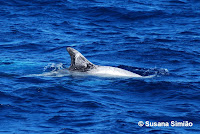2.30pm
This afternoon we headed towards the south of Pico. Antero had seem sperm whales in the morning and they were still in the area, heading east. Less than 1/2mile off Candelária, west of Pico, we encountered a small group of bottlenose dolphins (Tursiops truncatus) that remained not too close to the boat. We stayed with this dolphin group only a bit before heading close to Lajes do Pico, where the sperm whales (Physeter macrocephalus) were. We encountered 3 individuals foraging, just 1-2miles offshore. In this area of Pico the animals always pass really close to shore, because due to the bathymetry at this location it is the place where closer to shore you can encounter the greatest depth. On board with us was Lisa, who has been conducting research on sperm whales in the Azores for over 20years. She confirmed that one individual sperm whale we saw foraging had been photographed, for the first time, in 1988. That was 22years ago! It is great to know that this individual is still around.
Before heading back, we learnt there were Risso's dolphins (Grampus griseus) further offshore. We looked for them and encountered between 6-10 individuals. The wind was picking up and it was time to leave so we started heading back to Horta. Just off the harbour I noticed a small thing at the surface which seemed to me, at a distance, a small turtle head. I stood up to be able to see better underwater and identify the species, but to my surprise it was not a sea turtle. It was a ~2m beautiful hammerhead shark. I had never seen one before, so I was quite enthusiastic about it. Sharks are fish, but unlike the fish that we are used to eating they do not have bones. Instead their skeleton is made of cartilaginous tissue. Compared to cetaceans, they usually have 2 dorsal fins (depending on the species) instead of one, their tail is vertical instead of horizontal, and they have gills to breath instead of a blowhole. Unfortunately it was so fast I didn't have time to take a picture.
14:30
Esta tarde fomos até ao sul do Pico. O vigia Antero tinha visto cachalotes de manhã e estes ainda se encontravam na área, a dirigirem-se para este. A menos de meia milha fora da Candelária, na zona oeste do Pico, encontrámos um pequeno grupo de golfinhos roazes (Tursiops truncatus) que permaneceram um pouco afastados do barco. Apenas ficámos um curto período de tempo com este grupo antes de nos dirigirmos para perto das Lajes do Pico, onde os cachalotes (Physeter macrocephalus) estavam. Encontrámos 3 indivíduos com um comportamento de alimentação, apenas a 1-2milhas de terra. Nesta zona do Pico, os animais passam sempre muito perto da costa, devido à batimetria nesta zona em que é o local onde mais perto da costa se encontra a maior profundidade. A bordo connosco estava a Lisa, que já faz investigação em cachalotes nos Açores há mais de 20anos. Ela confirmou que um dos indivíduos que vimos tinha sido fotografado por ela, pela primeira vez, em 1988. Foi há 22anos atrás! É óptimo saber que este cachalote ainda está por aqui.
Antes de voltarmos à Horta, soubémos que havia grampos (Grampus griseus) mais longe da costa. Procurámo-los e encontrámos entre 6-10 indivíduos. O vento estava a aumentar e estava na hora de irmos embora por isso começámos a dirigir-nos de volta. Quase a entrar no porto notei numa pequena coisa à superfície da água que me pareceu, à distância, a cabeça de uma tartaruga. Levantei-me para poder ver melhor para debaixo de água e poder identificar a espécie, mas para minha surpresa não era uma tartaruga marinha. Era um lindo tubarão-martelo de cerca de 2m de comprimento. Nunca tinha visto nenhum, por isso fiquei logo contente plo avistamento. Os tubarões são peixes, mas ao contrário dos peixes que estamos habituados a comer, estes não possuem ossos. Em vez disso o seu esqueleto é composto de tecido cartilagíneo. Comparados com os cetáceos, costumam ter 2 barbatanas dorsais (dependendo das espécies) em vez de uma, a barbanata caudal está na posição vertical em vez de horizontal, e possuem guelras pra respirar em vez de espiráculo. Infelizmente, foi tão rápido que não consegui tirar uma fotografia.
Susana Simião

(bottlenose dolphins/golfinhos roazes)



PARA UMA LEIGA COMO EU QUE APENAS SABE APRECIAR UMA BELA PAISAGEM E CONTEMPLAR A MARAVILHA QUE É O MAR.....FICO FELIZ POR ALGUEM COMO A SUSANA SE PREOCUPAR EM PORMENORIZAR AS SUAS EXPERIENCIAS.
ResponderEliminarSE EU FOSSE MAIS JOVEM, ESTUDARIA BIOLOGIA MARINHA, DESDE QUE ACEITASSE SER MINHA PROFESSORA.
PARABENS E OBRIGADA PELA PARTILHA DE INFORMAÇÃO.
M.R.